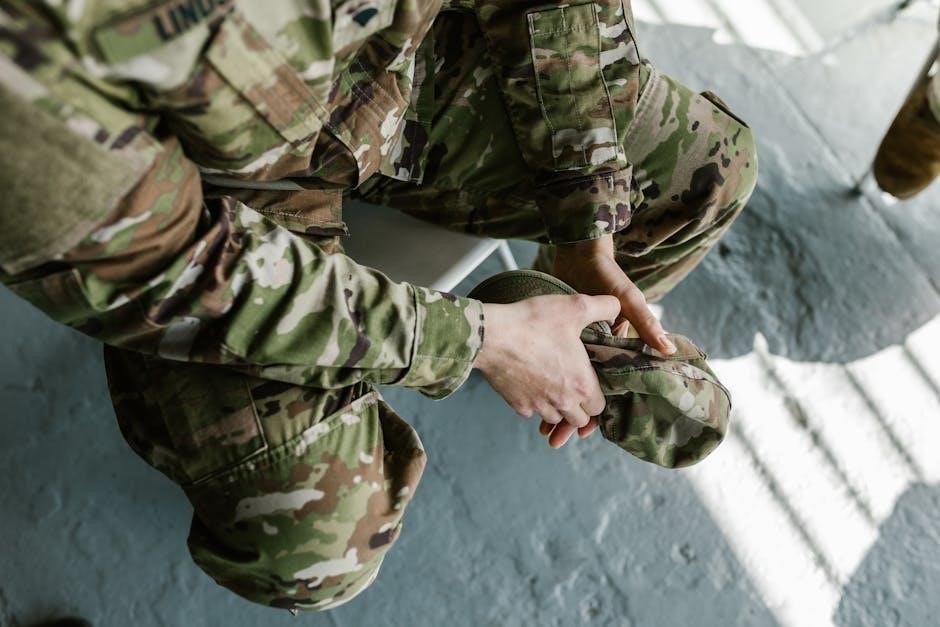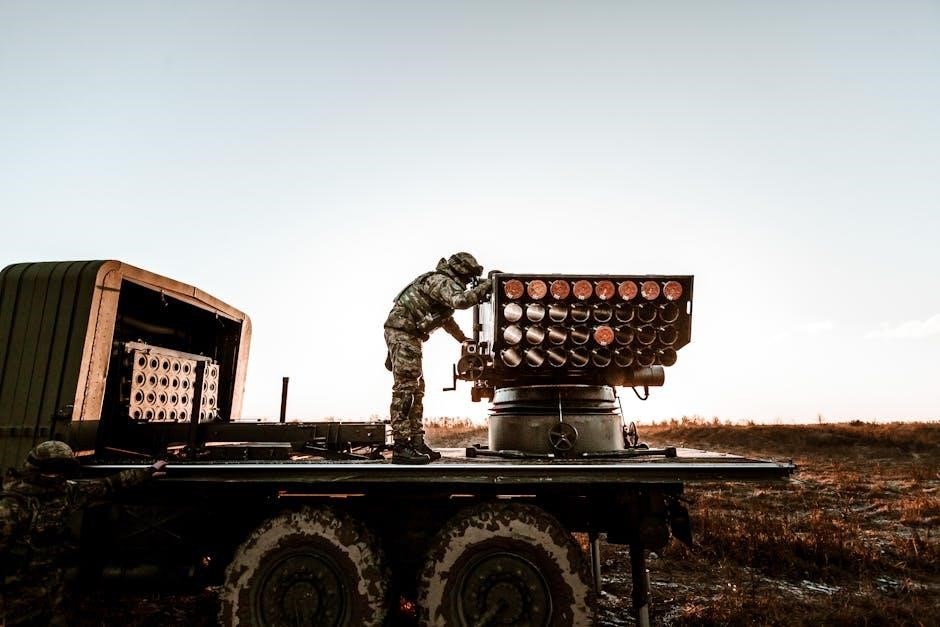
AR 190-11 provides guidelines for physical security, accountability, and control of arms, ammunition, and explosives․ It applies to all Army personnel and facilities, ensuring compliance with safety standards․
1․1 Purpose and Scope of AR 190-11
AR 190-11 establishes policies and procedures for the physical security of arms, ammunition, and explosives (AA&E)․ Its purpose is to ensure the safe storage, handling, and accountability of these items to prevent unauthorized access or theft․ The regulation applies to all Army personnel, facilities, and activities involving AA&E․ It outlines standards for securing weapons, conducting inspections, and maintaining accountability․ The scope includes guidance on storage facilities, access control, and emergency procedures․ Compliance is mandatory to safeguard sensitive items and protect personnel and resources․ This regulation is essential for maintaining operational readiness and ensuring the security of military assets․
1․2 Overview of Physical Security Measures
AR 190-11 outlines comprehensive physical security measures to safeguard arms, ammunition, and explosives․ These measures include secure storage facilities, access control, and electronic security systems․ The regulation emphasizes key control, locking devices, and surveillance to prevent unauthorized access․ It also addresses the use of alarms, motion detectors, and video monitoring to enhance security․ Regular inspections are required to ensure compliance with these measures․ The goal is to protect sensitive items from theft, loss, or sabotage while maintaining accountability․ These measures are critical for maintaining operational security and ensuring the safety of personnel and resources․ Compliance is mandatory for all Army facilities and activities․
Key Components of AR 190-11
AR 190-11 covers definitions, safeguarding policies, roles, storage, transportation, inspections, and training․ It ensures accountability, security, and compliance for arms, ammunition, and explosives, with regular updates․
2․1 Definitions and Terminology
AR 190-11 defines key terms essential for understanding its requirements․ “Arms” include weapons like rifles and pistols, while “ammunition” refers to projectiles and propellants․ “Explosives” are materials that detonate, and “sensitive items” are critical for security․ “Accountability” ensures tracking and reporting of all items, and “physical security” encompasses measures to protect them․ These definitions provide a clear framework for safeguarding and compliance, ensuring uniform understanding across Army personnel and facilities․ Proper terminology usage is vital for effective implementation of the regulation’s policies and procedures․
2․2 Policies on Safeguarding Arms, Ammunition, and Explosives
AR 190-11 establishes strict policies for safeguarding arms, ammunition, and explosives (AA&E)․ These policies ensure proper control, accountability, and security to prevent loss, theft, or unauthorized access․ Key measures include storing AA&E in secure, authorized facilities with locking mechanisms and alarms․ Access is restricted to authorized personnel only, and regular inspections are mandatory․ The regulation emphasizes the importance of maintaining accurate inventory records and conducting periodic checks to verify the presence of all items․ Compliance with these policies is critical to maintaining operational readiness and preventing potential security breaches․ Failure to adhere to these guidelines may result in severe consequences, as outlined in the regulation․
2․3 Roles and Responsibilities
AR 190-11 assigns specific roles to ensure accountability and security of arms, ammunition, and explosives․ Commanding officers are responsible for overall compliance and implementing security measures․ Physical security managers oversee inspections and training programs․ All personnel must adhere to established procedures and report any discrepancies․ This clear division of responsibilities ensures effective security and accountability across all levels, maintaining operational readiness and preventing security breaches․

Storage and Accountability
AR 190-11 outlines storage requirements for arms, ammunition, and explosives, ensuring secure facilities and strict inventory control to maintain accountability and prevent unauthorized access or theft․
3․1 Storage Facilities and Requirements
Storage facilities for arms, ammunition, and explosives must meet strict security standards, including controlled access, reinforced construction, and advanced locking systems․ All items must be segregated based on classification and sensitivity․ Fire-resistant materials and fire suppression systems are mandatory to prevent accidental ignition․ Access is restricted to authorized personnel with proper clearance, and all storage areas must be continuously monitored․ Regular inspections ensure compliance with safety protocols and physical security measures․ These requirements are designed to protect sensitive items from theft, damage, or unauthorized access, maintaining operational readiness and security integrity across all Army installations and facilities․
3․2 Inventory Management and Reporting
AR 190-11 mandates rigorous inventory management and reporting procedures to ensure accountability of arms, ammunition, and explosives․ Commanders must conduct regular audits and physical counts to verify the presence and condition of all items․ Discrepancies must be reported immediately, with corrective actions taken to resolve issues․ Inventory records must be maintained accurately, with digital systems often used for real-time tracking․ Reporting requirements include submitting periodic inventory reports to higher headquarters, ensuring transparency and compliance with regulatory standards․ These practices prevent unauthorized access, theft, or misuse, maintaining operational readiness and accountability across all Army installations and units․ Compliance is non-negotiable for mission success․
3․3 Electronic Security Systems
AR 190-11 emphasizes the use of electronic security systems to enhance the protection of arms, ammunition, and explosives․ These systems include intrusion detection, surveillance cameras, and access control mechanisms to monitor and secure storage facilities․ The regulation requires that electronic systems be integrated into overall security plans, ensuring real-time monitoring and rapid response to breaches․ Regular maintenance and inspections of these systems are mandated to ensure reliability and effectiveness․ Electronic security measures are tailored to the sensitivity and location of stored items, providing an additional layer of protection against unauthorized access or theft․ This ensures the integrity and accountability of critical military assets․

Transportation and Movement
AR 190-11 outlines procedures for transporting arms, ammunition, and explosives, ensuring secure movement using authorized vehicles, escorts, and documentation to maintain accountability and prevent unauthorized access․
4․1 Transportation Procedures
AR 190-11 specifies that transportation of arms, ammunition, and explosives must follow strict protocols to ensure security and accountability․ All movements require pre-planning, including route selection, vehicle security, and escort details․ Vehicles used for transport must meet specific safety and security standards, such as being fully enclosed and equipped with locking mechanisms․ Sensitive items must be stored in sealed, tamper-evident containers․ Documentation, including manifests and transportation orders, must accompany all shipments․ Real-time tracking and communication are mandatory to monitor the movement of sensitive materials․ Deviations from approved routes or procedures are prohibited without higher authority approval․ Accountability is maintained throughout the transport process․
4․2 Escorts and Security Measures During Transport
AR 190-11 mandates that all transports of arms, ammunition, and explosives must be escorted by authorized personnel․ Escorts are responsible for maintaining visual surveillance and ensuring the integrity of the shipment․ Security measures include the use of armed personnel, secure communication devices, and emergency response plans․ Vehicles must be equipped with GPS tracking and alarm systems to deter and respond to potential breaches․ Escorts must adhere to established protocols, including regular checks and maintaining minimum safe distances․ Additional security may be required for high-value or sensitive items, such as explosives․ Compliance with these measures ensures the safe and secure transport of military materials․
4․3 Documentation and Tracking
AR 190-11 requires detailed documentation and tracking for all transported arms, ammunition, and explosives․ This includes manifests, inventory checks, and electronic tracking systems to ensure accountability․ GPS tracking devices are often used to monitor shipments in real-time․ Documentation must be maintained for audit purposes, detailing the type, quantity, and destination of items․ Any deviations from the planned route or schedule must be reported and documented immediately․ Proper tracking ensures the secure movement of sensitive materials and prevents unauthorized access or theft․ Compliance with these procedures is critical to maintaining operational security and adhering to regulatory standards․ Accurate records are essential for accountability and audit compliance․

Inspections and Audits
AR 190-11 outlines inspection and audit processes to ensure compliance with physical security standards․ Regular inspections verify storage, accountability, and documentation of arms, ammunition, and explosives, while audits ensure adherence to regulatory requirements and identify vulnerabilities for corrective action․
5․1 Frequency and Types of Inspections
AR 190-11 specifies that inspections of arms, ammunition, and explosives must be conducted regularly to ensure compliance․ These inspections include daily checks, weekly inventories, and monthly audits․ Annual inspections are also mandated to verify the overall security and accountability of sensitive items․ Types of inspections vary from visual checks of storage facilities to detailed audits of documentation and inventory management systems․ Random inspections may be conducted to assess readiness and compliance with security protocols․ Each inspection type serves to identify vulnerabilities, ensure accountability, and maintain the integrity of physical security measures across all Army facilities and operations․
5․2 Inspection Checklists and Criteria
AR 190-11 outlines detailed inspection checklists and criteria to ensure comprehensive evaluation of physical security measures․ These checklists cover storage facilities, inventory accuracy, and documentation standards․ Inspectors verify that all arms, ammunition, and explosives are properly secured, labeled, and accounted for․ Criteria include adherence to locking mechanisms, access controls, and surveillance systems․ The regulation also provides guidelines for evaluating the condition of storage areas and the implementation of electronic security systems․ Inspection checklists are standardized to ensure consistency across all facilities, with specific focus on high-risk items and sensitive materials․ This systematic approach ensures compliance and maintains the integrity of security protocols․
5․3 Corrective Actions for Non-Compliance
AR 190-11 mandates immediate corrective actions for non-compliance with physical security protocols․ Units must identify the root cause of violations and implement remedial measures to prevent recurrence․ Commanders are responsible for ensuring compliance and may impose disciplinary actions․ Corrective actions include retraining personnel, enhancing security measures, and conducting follow-up inspections․ Severe violations may result in legal actions under the Uniform Code of Military Justice․ The regulation emphasizes accountability at all levels to maintain the integrity of security standards and protect sensitive items from unauthorized access or theft․ Timely resolution of non-compliance ensures operational readiness and safety within military facilities․

Privately Owned Weapons
AR 190-11 regulates the possession, registration, and storage of privately owned weapons on Army installations․ Owners must comply with specific guidelines to ensure safekeeping and accountability․
6․1 Registration Requirements
AR 190-11 mandates that all privately owned weapons (POWs) must be registered with the installation’s provost marshal or designated authority․ Personnel must complete a registration form, typically DA Form 4187, and provide proof of eligibility to possess the weapon․ This ensures accountability and prevents unauthorized access․ The regulation applies to all military personnel, civilians, and contractors who bring POWs onto Army installations․ Registration helps maintain security and accountability, reducing risks associated with unauthorized weapons․ Failure to register may result in confiscation or disciplinary action․ Proper documentation is essential to comply with Army policies and maintain a secure environment․
6․2 Storage of Privately Owned Weapons
AR 190-11 requires privately owned weapons (POWs) to be stored securely in the owner’s quarters or approved storage facilities․ Weapons must be stored in a locked safe, container, or with a locking device to prevent unauthorized access․ Ammunition should be stored separately from the weapon․ Storage in vehicles is prohibited except in emergencies, and even then, weapons must be secured in a locked compartment or trunk․ Commanders may authorize alternative storage solutions under specific conditions․ Proper storage ensures safety, prevents theft, and maintains accountability․ Non-compliance may result in disciplinary action or confiscation of the weapon․ Secure storage is critical to maintaining a safe military environment․
6․3 Transportation of Privately Owned Weapons
Transportation of privately owned weapons (POWs) must comply with local laws and base regulations․ Weapons must be unloaded, securely locked in a container, and stored out of sight․ Ammunition should be transported separately from the weapon․ Personnel must carry their POW registration when transporting weapons on base․ Weapons may not be left unattended in vehicles, even if locked․ Violations of transportation rules may result in confiscation or disciplinary action․ Proper transportation ensures safety, prevents unauthorized access, and maintains accountability․ Adhering to these guidelines is essential for personal and community security within military installations․

Explosives and Sensitive Items
AR 190-11 details enhanced security measures for explosives and sensitive items, including handling, storage, and access restrictions to prevent unauthorized use or theft․
7․1 Handling and Storage of Explosives
AR 190-11 outlines strict guidelines for handling and storing explosives, emphasizing secure facilities with controlled access and surveillance․ Storage areas must meet specific safety standards to prevent accidents or unauthorized access․ Explosives are categorized by sensitivity, with corresponding storage requirements to mitigate risks․ Access is restricted to authorized personnel, and all activities must be documented․ Regular inspections ensure compliance with safety protocols, and training is mandatory for handlers․ Proper labeling and segregation of materials are required to avoid cross-contamination or mishandling․ The regulation also addresses emergency procedures for spills or breaches, ensuring prompt response to minimize hazards․ Compliance is critical to maintaining operational safety and security․
7․2 Security Measures for Sensitive Items
AR 190-11 mandates robust security measures for sensitive items, including access control, surveillance, and secure storage․ Sensitive items must be stored in approved containers with locking mechanisms․ Access is restricted to authorized personnel, verified through ID checks or biometric authentication․ Continuous surveillance, such as CCTV, is required for storage areas․ Alarm systems must be installed to detect unauthorized access․ Regular inspections and audits ensure compliance with security protocols․ Personnel handling sensitive items must undergo background checks and training․ Any breach or unauthorized access must be reported immediately, with corrective actions taken to prevent recurrence․ Compliance ensures the integrity and safety of sensitive military assets․
7․3 Emergency Procedures
AR 190-11 outlines emergency procedures for incidents involving arms, ammunition, and explosives․ In case of an explosion, fire, or spill, immediate evacuation and containment protocols must be activated․ Personnel must alert authorities and follow established safety measures․ First responders are trained to handle such situations, ensuring minimal damage and risk․ Emergency kits and communication devices must be readily available․ Post-incident, a thorough investigation is conducted to identify causes and prevent future occurrences․ Training on emergency procedures is mandatory for all personnel handling sensitive items․ Compliance with these measures ensures safety and accountability during critical events, minimizing risks to personnel and assets․

Facility-Specific Regulations
AR 190-11 includes specific guidelines for facilities like Fort Knox and Joint Base Lewis-McChord, ensuring tailored security measures for unique operational needs and locations․
8․1 Fort Knox Regulations
Fort Knox-specific regulations under AR 190-11 focus on stringent security measures for privately owned weapons․ All personnel must register firearms, store them securely, and adhere to transportation guidelines within the base․ The regulation ensures accountability and safety, preventing unauthorized access to weapons․ Compliance is mandatory for personnel and visitors, with specific procedures for temporary storage and movement of firearms․ These rules align with broader Army standards while addressing the unique security needs of Fort Knox․
8․2 Joint Base Lewis-McChord Regulations
Joint Base Lewis-McChord (JBLM) has specific guidelines under AR 190-11, focusing on physical security for arms, ammunition, and explosives․ The regulation mandates strict key and lock control, electronic security systems, and detailed documentation for all sensitive items․ Personnel must adhere to JBLM’s tailored requirements for weapon storage, access, and accountability․ These measures ensure compliance with Army standards while addressing the base’s unique operational needs․ The regulation also emphasizes regular inspections and audits to maintain security integrity and prevent unauthorized access to sensitive materials, ensuring JBLM’s adherence to AR 190-11 protocols for the protection of AA&E․

Penalties and Violations
Violations of AR 190-11 may result in administrative or legal actions, ensuring accountability and adherence to security protocols, with penalties ranging from reprimand to court-martial, and ensure compliance․
9․1 Consequences of Non-Compliance
Failure to comply with AR 190-11 may result in administrative or legal actions․ Personnel found negligent in safeguarding arms, ammunition, or explosives face potential disciplinary measures, including reprimands or loss of privileges․ Severe violations can lead to court-martial under the Uniform Code of Military Justice (UCMJ)․ Non-compliance jeopardizes operational readiness and security, making it a serious offense․ Commanders are responsible for ensuring accountability and enforcing penalties to maintain standards and prevent breaches․ Consequences extend beyond individuals, impacting unit integrity and mission success, emphasizing the importance of strict adherence to the regulation․ Penalties are proportionate to the severity of the violation․
9․2 Reporting Violations
Reporting violations of AR 190-11 is essential to maintain accountability and security․ All personnel must report any unauthorized access, theft, or misuse of arms, ammunition, or explosives to their chain of command․ Reports should include details of the incident, including dates, times, and individuals involved․ Commanders are responsible for investigating and documenting violations, ensuring corrective actions are taken․ Failure to report violations can result in additional penalties․ Timely reporting helps prevent further breaches and ensures compliance with security protocols․ Confidentiality is maintained to protect whistleblowers, encouraging transparency and accountability within the ranks․ Proper reporting upholds the integrity of the regulation and unit security․
9․4 Legal Actions
Legal actions under AR 190-11 are imposed for serious violations of physical security protocols․ Personnel found guilty of unauthorized access, theft, or misuse of arms, ammunition, or explosives face court-martial proceedings․ Charges may include larceny, dereliction of duty, or violations of the Uniform Code of Military Justice (UCMJ)․ Legal actions are pursued to maintain accountability and deter future violations․ Administrative measures, such as loss of security clearance or discharge, may also be enforced․ Legal consequences emphasize the severity of non-compliance, ensuring the protection of sensitive items and maintaining operational integrity․ Legal actions are a critical component of enforcing AR 190-11 standards․

Training and Awareness
AR 190-11 mandates mandatory training for personnel handling arms, ammunition, and explosives․ Annual security awareness programs and refresher courses ensure compliance and mitigate risks effectively․
10․1 Mandatory Training Requirements
AR 190-11 requires all personnel handling arms, ammunition, and explosives to complete mandatory training․ Annual refresher courses ensure adherence to security protocols and proper handling procedures․ The training covers storage, transportation, and emergency response․ It emphasizes accountability and physical security measures․ Personnel must demonstrate proficiency in safeguarding sensitive items and understanding inspection criteria․ Training programs are tailored to specific roles, ensuring compliance with the regulation’s standards․ This ongoing education helps prevent violations and maintains operational readiness․ Adherence to these requirements is critical for minimizing risks and ensuring the security of AA&E across all Army facilities and operations․
10․2 Security Awareness Programs
Security awareness programs under AR 190-11 are designed to educate personnel on the importance of physical security protocols․ These programs emphasize the prevention of theft, unauthorized access, and mishandling of arms, ammunition, and explosives․ Regular briefings and visual aids are used to reinforce security practices․ All personnel, including those with limited access, must participate to ensure a culture of vigilance․ The programs highlight the consequences of non-compliance and provide practical tips for safeguarding sensitive items․ This continuous education complements mandatory training and inspections, ensuring that security remains a priority at all levels of operation․
10․3 Refresher Courses
Refresher courses under AR 190-11 ensure continuous adherence to physical security standards․ These courses are conducted periodically to update personnel on the latest policies, procedures, and best practices․ They cover key topics such as handling sensitive items, proper storage techniques, and emergency response protocols․ Hands-on training and scenario-based exercises are often included to reinforce learning․ Participation is mandatory for all personnel involved in the custody or handling of arms, ammunition, and explosives․ Records of completion are maintained to ensure accountability and compliance with regulatory requirements․ Refresher courses play a critical role in maintaining a high level of security awareness and operational readiness․

Updates and Revisions
AR 190-11 undergoes periodic revisions to enhance security measures and adapt to emerging threats․ Updates are issued by the Provost Marshal General, effective from 01/17/2019․
11․1 Recent Changes to AR 190-11
Recent updates to AR 190-11, effective from 01/17/2019, include enhanced security protocols for sensitive items and improved accountability measures․ The regulation now emphasizes advanced electronic security systems and stricter access controls․ Key changes involve updated procedures for storage facilities, transportation, and inventory management․ Additionally, the revised regulation strengthens policies on privately owned weapons and explosives handling․ These modifications aim to address modern security threats and ensure compliance with evolving safety standards․ The updates also clarify roles and responsibilities, particularly for commanding officers, to maintain the highest level of physical security across all Army installations and operations․
11․2 Future Updates and Amendments
Future updates to AR 190-11 are expected to incorporate advancements in technology and address emerging security challenges․ The regulation may expand its scope to include new protocols for electronic security systems and enhanced accountability measures․ Additionally, updates could focus on improving procedural efficiency and ensuring compliance with evolving safety standards․ The Army may also introduce stricter guidelines for sensitive items and explosives handling․ These amendments aim to maintain the highest level of physical security while adapting to modern threats․ The updates will likely undergo a thorough review process before implementation to ensure they align with the Army’s overall security objectives and operational needs․
11․3 Implementation of Changes
Implementation of changes to AR 190-11 involves a structured process to ensure compliance across all Army installations․ Updates are communicated through official channels, with training sessions conducted for personnel․ Units are required to review and adapt their procedures within a specified timeframe․ Compliance is verified through inspections and audits, with corrective actions taken for non-compliance․ Commanders are responsible for overseeing the implementation process, ensuring that all modifications align with operational requirements․ The goal is to maintain seamless security while integrating new guidelines effectively․ This systematic approach ensures that physical security standards remain robust and up-to-date with current threats and technological advancements․




